Group 2 Notes
Aceraceae
Habit: mostly trees in this family, leaves opposite, simple and palmate or pinnately compound with 3-7 leaflets that are ovate to elliptical in shape, 3 bundle scars with clustered end buds. Flowers can be perfect and imperfect producing monecious and dioecious species. Flowers can be dangling or produced on spus shoots on the ends of branches. Double samara fruit type.
Ecology: found throughout the northern hemisphere, often planted as ornamentals
Use: Acer saccharum Marsh. Provides maple syrup while other maples used for constructions such as cabinets.
- Acer pensylvanicum (striped maple)
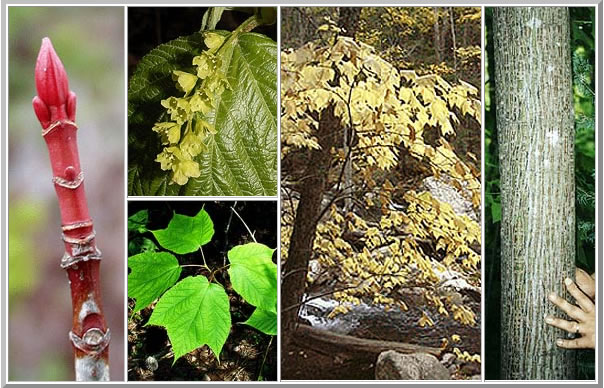
- Leaf: Opposite, simple, orbicular, 5 to 8 inches long, 3-lobed (resembles a goose foot), serrated margin; green above and paler below.
- Flower: Dioecious; yellow-green, bellshaped, 1/4 inch long, appear in long, hanging slender clusters in late spring.
- Fruit: Paired, wide-spreading samaras, 3/4 to 1 inch long, in hanging clusters, ripen in late summer and early fall.
- Twig: Moderately stout, green changing to red or reddish brown, smooth; reddish buds narrowly ovoid, stalked, valvate.
- Bark: When young, smooth gray-green with prominent white lengthwise stripes, older bark becomes reddish brown.
- Form: Small tree or large shrub up to 30 feet tall.
- Acer negundo (Boxelder or Ashleaf Maple)
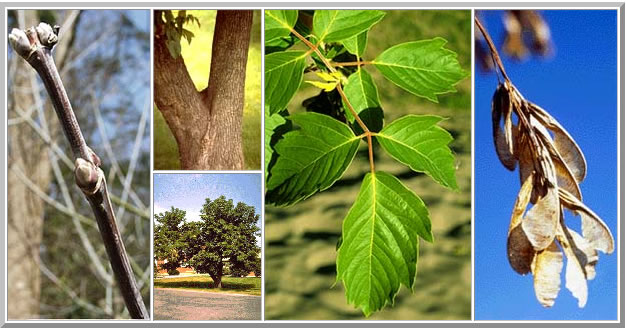
- Leaf: Opposite, pinnately compound, 3 to 5 leaflets (sometimes 7), 2 to 4 inches long, margin coarsely serrate or somewhat lobed, shape variable but leaflets often resemble a classic maple leaf, light green above and paler below.
- Flower: Dioecious; yellow-green, in drooping racemes; appearing in spring.
- Fruit: Paired V-shaped samaras, 1 to 1 1/2 inches long, in drooping clusters,light tan when ripe in fall, persist throughout winter.
- Twig: Green to purplish green, moderately stout, leaf scars narrow, meeting in raised points, often covered with a glaucous bloom; buds white and hairy, lateral buds appressed.
- Bark: Thin, gray to light brown, with shallow interlacing ridges; young bark is generally warty.
- Form: Medium sized tree to 60 feet, typically with poor form and multiple trunks; sprouts often occur on bole.
- Acer rubrum (Red Maple)
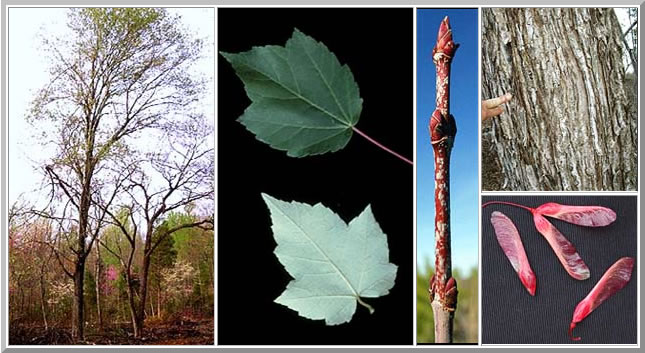
- Leaf: Opposite, simple, 3 to 5 palmate lobes with serrated margin, sinuses relatively shallow (but highly variable), 2 to 4 inches long; green above, whitened and sometimes glaucous or hairy beneath.
- Flower: Attractive but small, occur in hanging clusters, usually bright red but occasionally yellow, appear in early spring, usually before leaves.
- Fruit: Clusters of 1/2 to 3/4 inch long samaras with slighly divergent wings, on long slender stems. Light brown and often reddish, ripen in late spring and early summer.
- Twig: Reddish and lustrous with small lenticels, buds usually blunt, green or reddish (fall and winter) with several loose scales usually present, leaf scars V-shaped, 3 bundle scars, lateral buds slightly stalked, may be collateral buds present.
- Bark: On young trees, smooth and light gray, with age becomes darker and breaks up into long, fine scaly plates.
- Form: Medium sized tree up to 90 feet. In forest, trunk usually clear for some distance, in the open the trunk is shorter and the crown rounded.
Acer saccharinum silver maple
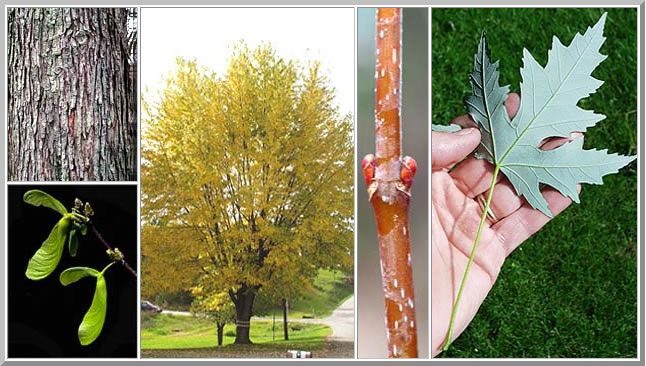
- Leaf: Opposite, simple with 5 deeply palmate sinuses, lobe margins coarsely serrate, 2 1/2 to 5 inches long; light green above, pale, silvery white below.
- Flower: Monoecious; greenish to reddish flowers appear in dense clusters in early spring long before leaves.
- Fruit: Samara, largest of any native maple, divergent wings 1 1/2 to 2 1/2 inches long, germinate as soon as released, mature in late spring.
- Twig: Similar to red maple but stouter and often more chestnut-brown in color, unpleasant odor when crushed; buds reddish brown with large scales, flower buds often in conspicuous dense clusters.
- Bark: Light gray and smooth when young, when older breaks up into long thin strips, loose at ends. Similar to red maple but coarser.
- Form: Can become quite a large tree reaching over 100 feet tall, trunk usually short, dividing into several subtrunks. Long slender branches sweep downward and then curve gracefully upwards.
Acer saccharum sugar maple
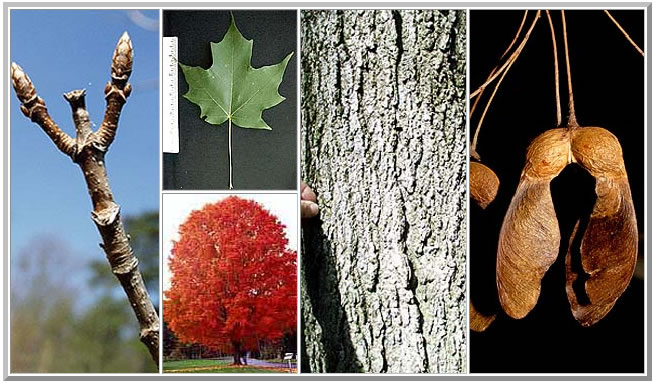
- Leaf: Opposite, simple and palmately veined, 3 to 6 inches long, 5 delicately rounded lobes, entire margin; green above, paler below.
- Flower: Light yellow-green, small, clustered, hanging from a long, slender (1 to 3 inch) stem, appearing with or slightly before the leaves in early spring.
- Fruit: Two-winged horseshoe-shaped samaras about 1 inch long, appearing in clusters, brown when mature in in the fall.
- Twig: Brown, slender and shiny with lighter lenticels; terminal buds brown, very sharp pointed, with tight scales.
- Bark: Variable, but generally brown, on older trees it becomes darker, develops furrows, with long, thick irregular curling outward, firm ridges.
- Form: Medium to tall tree (to 100 feet) with very dense elliptical crown.
Acer platanoidesNorway maple
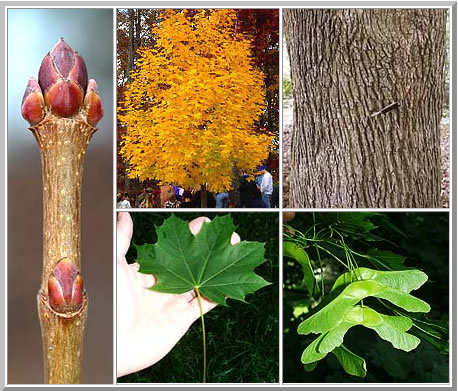
- Leaf: Opposite, simple, and palmately-veined, 5 to 7 lobed with long pointed "teeth", exudes milky white sap from the petiole when detached, dark green above, paler below. A purple (nearly black) leaf variety known as Crimson King is widely planted.
- Flower: Appear in early spring, before leaves; bright yellow-green in color, with male and female usually on different trees.
- Fruit: Widely divergent 2-winged samaras, 1 1/2 to 2 inches long in clusters, relatively flat seed cavity, mature in late summer and persist into the winter.
- Twig: Stout, brown with a large, turban-shaped, green to purple(fall and winter) terminal bud, large bud scales.
- Bark: Gray-brown, a bit corky, on older trees shallowly furrowed with long narrow, somewhat interlacing ridges.
- Form: Medium sized tree to 80 feet tall, usually with a dense rounded crown.
Anacardiaceae
Habit: Usually shrubs and woody vines, leaves alternate and pinnately compound, single bud scale on terminal bud, milky or sticky sap preent in all individual members, plants can be monecious and dioecious, greenish flowers can be perfect and imperfect usually in dense panicles at the terminal twig, fruit is a berry.
Ecology: most members of this family found in the southern hemisphere. Members in our region often prefer moist sites.
Use: a lemonade like drink can be made from the fruit, but normally members of this plant are avoided!
Rhus typhina staghorn sumac

- Leaf: Alternate, pinnately compound, 16 to 24 inches long, with 11 to 31 lanceolate leaflets with serrate margins each 2 to 5 inches long, rachis fuzzy; green above and paler below.
- Flower: Often Dioecious; small, with yellow-green petals, borne on upright, dense terminal cluster up to 8 inches long, appearing in mid-summer.
- Fruit: A round (1/8 inch diameter), red, fuzzy drupe; borne on upright dense clusters; mature in late summer, but persist through winter.
- Twig: Stout, brown and very fuzzy (resembling deer antlers in velvet); buds are small, rounded and covered with soft, brown hairs, nearly encircled by leaf scar.
- Bark: Remaining fuzzy for several years, turning gray-brown and smooth with numerous lenticels, much later becoming a bit scaly.
- Form: A shrub or small tree to 25 feet, with a short, often poorly formed trunk and wide spreading very open crown. Branches repeatedly and widely fork.
Toxicodendron radicans poison-ivy\

- Leaf: Alternate, pinnately compound with 3 leaflets, 7 to 10 inches long, leaflets are ovate and irregularly toothed, shiny green above above, paler below. TOXIC.
- Flower: Monoecious; small, yellowish green, appearing in clusters, present late spring to early summer. TOXIC.
- Fruit: Greenish white, round, 1/4 inch in diameter, borne in a hanging cluster, ripe in late summer and persist through winter. TOXIC.
- Twig: Slender, gray- to red-brown, sparingly pubescent or glabrous, slender aerial roots present and older growth becomes densely covered and "hairy" in appearance; buds are stalked, naked, fuzzy brown, 1/4 inch long. TOXIC.
- Bark: Dark gray, densely covered in aerial roots. TOXIC.
- Form: May be present as a low (6 to 18 inches), spreading "carpet" on the forest floor, as a climbing vine, or as a bush.
Araliaceae
Habit: woody and non-woody members in this family, bi or tri-pinnately compound leaves, alternate. Some members in this family have spines on the branches and/or undersides of leaves. Woody members have large overlapping bud scales. Flowers perfect and imperfect and often clustered in large compound panicles. Fruit is a drupe or berry.
Ecology: members found throughout both hemispheres in a variety of habitat types.
Use: Panax quinquefolius L. is an herbaceous member of this family that can bring in prices of $350-600/dry pound of root material.
Aralia spinosa Devil's walking stick
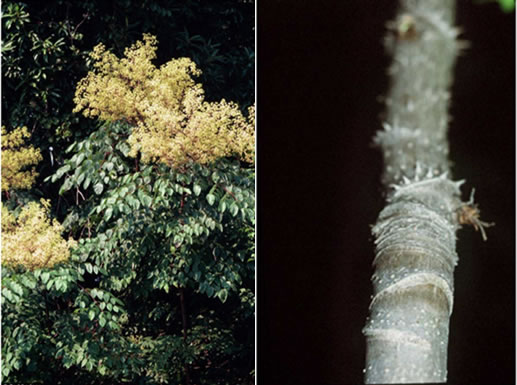
- Leaf: Alternate, bi- or tri-pinnately compound, up to 5 feet long; leaflets are 2 to 4 inches long, serrated margin; rachis has scattered prickles; green to blue-green above and paler below.
- Flower: Monoecious; white and quite small, borne on 12 to 18 inch clusters at the ends of branches, appearing in late summer.
- Fruit: A round, fleshy drupe, purple to black and 1/4 inch long; borne in quantity on pink-red clusters; maturing in late summer and early fall.
- Twig: Very stout and spiny, gray to straw colored, with a slender U-shaped leaf scars that encircle 1/2 of the stem; buds are relatively small, ovoid and oppressed with very few scales.
- Bark: Gray-brown, spines persisting for some time, largest trees become shallowly furrowed.
- Form: A large shrub or small tree (up to 30 feet) with club-shaped branches; root sprouts and often forms thickets.
Panax quinquefolius (American ginseng)

- This aromatic herbaceous perennial has once palmately compound leaves arranged in a single whorl. The leaves are oblong-obovate to obovate, 6-15 cm, and conspicuously serrate. The stems are solitary, 2-6 dm, and with one flower umbel per stem. The flowers are greenish-white, all or mostly perfect. There are two styles and five stamens. The fruits are berry-like, bright red drupes, 1 cm thick.
Aquifoliaceae
Habit: primarily woody family, alternate, simple leaves often evergreen with bristle tips unique to some members, most members dioecious, flowers small with four green-white petals appearing in late spring for most species, fruit is a berry.
Ecology: found throughout the northern hemisphere.
Use: most members of this family are used for ornamental purposes as lawn shrubs. Many cultivars exist within this family.
Ilex opaca American Holly

- Leaf: Alternate, simple, evergreen, elliptical, 2 to 4 inches long, spiny toothed margin, thickened and leathery, shiny dark green above, much paler below.
- Flower: Dioecious; dull green-white, male flowers on 3 to 7 flowered cymes, female flowers are solitary with a pleasant odor, appearing in late spring.
- Fruit: Berry-like drupe, red, rarely yellow when ripe, 1/4 inch in diameter, containing ribbed nutlets; maturing in fall and persisting on tree into winter.
- Twig: Slender, with rust-colored pubescence; buds small reddish brown, pointed.
- Bark: Light gray and smooth regardless of size.
- Form: A small tree to 40 feet, with a thick crown and pyramidal form, usually with branches to the ground.
Berberidaceae
Habit: Family contains both woody and herbaceous members. One of the most mis-matched families in existence. Leaves generally simple and alternating, but can be palmate or deeply incised in leaf shape. Leaves can also be leathery and somewhat persistent in some members where spines are present. Fruit is generally a berry.
Ecology: Although some members of this family are invasive generalists in our region two important native members prefer moist shaded areas in well drained soils.
Use: Berberine present in many members as an isoquinoline alkaloid with a bright yellow color that is used for dyes. Medicinally it is now used to lower blood pressure and chloresterol. Podophyllum peltatum L. Mayapple or Wild Mandrake and Caulophyllum thalictroides (L.) Michx. Blue Cohosh or Squaw Root are both native herbaceous species found in this family that were medicinally important to Native Americans and Mountain people in Appalachia.
Berberis thunbergii Japanese barberry
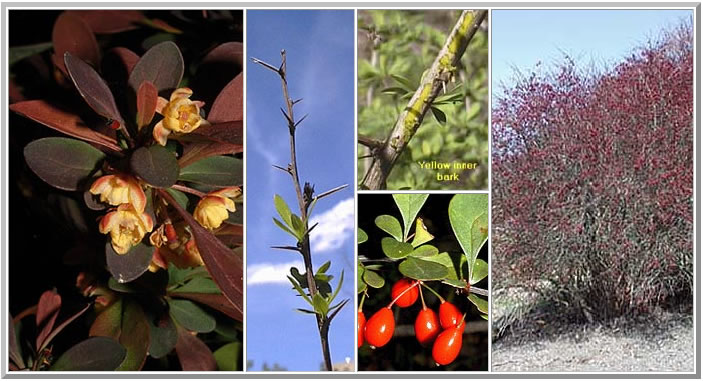
- Leaf: Alternate, simple, entire margin, spatulate or obovate, 1/2 to 1 1/2 inches long, bright green above, paler and somewhat glaucous below.
- Flower: Pale yellow, 1/3 inch across, usually in small clusters, appearing in April to May.
- Fruit: Shiny red, egg-shaped berry, 1/3 inch long, ripening in the fall and persisting into the next spring.
- Twig: Slender, angled or grooved and zigzagged, brown, buds small, thorns at each node, yellow inner bark.
- Bark: Gray-brown, finely shreddy.
- Form: Small bush with a round dense crown, reaching several feet tall.
Podophyllum peltatum May apple
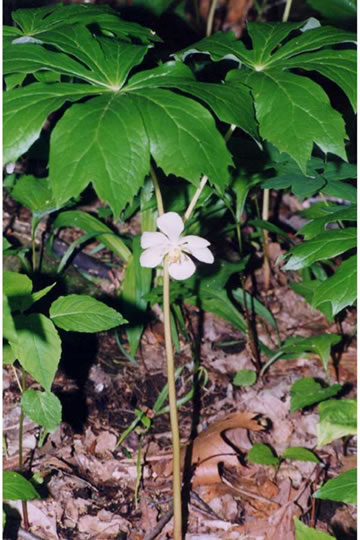
- most commonly known as the mayapple, but in various regions it is also known as Devil's apple, hog apple, Indian apple, umbrella plant, wild lemon, and American mandrake (though it should not be confused with true mandrake, Mandragora officinarum, an unrelated Old World plant whose roots have been used throughout history for medicines and potions).
- These plants reach 6-18 inches in height and grow in patches. Each plant has a single stalk topped with one or two broad, deeply divided leaves that vaguely resemble umbrellas. The two-leaved plants normally produce a single, small white flower (usually in May, thus the name) from the fork in the stem. The flower develops into a pulpy, lemon-yellow berry which ripens in late summer and is the only part of the plant that isn't poisonous (however, the berries should only be eaten in moderation, if at all).
Caulophyllum thalictroides Blue cohosh
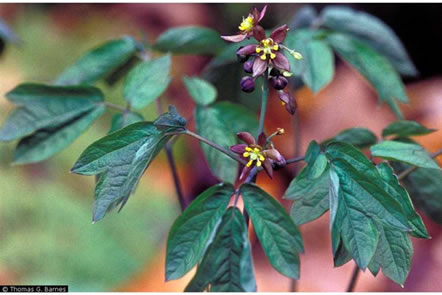
- Stems - From rhizomes, to +/-50cm tall, erect, herbaceous, multiple from the base, glaucous, terete, green with purple at the base, glabrous.
- Leaves - Mostly one leaf per stem, triternate. Leaflets 3(4-5)-lobed a the apex, entire, glabrous, 4-5cm long, +/-3cm broad. Lobes of the leaflets acute, with a small whitish apex. Main veins of the leaflets arising from the base of the leaflet. All veins impressed above, expressed below. Lateral leaflets often oblique at the base.
- Inflorescence - Axillary panicle to +4cm long. Peduncle to +3cm long, glabrous. Ech division of the panicle subtended a minute bract. Bracts 1-2mm long, acute, scarious on the margins.
- Flowers - Petaloid sepals 6, yellow-green, spatulate, rounded at the apex, +/-5mm long, 2-3mm broad, with slightly darker veins, distinct. Petals smaller than the sepals, green, glabrous, hooded, 2mm long, 2mm broad at the apex. Stamens 6, ascending. Filaments green, glabrous, 1.5mm long. Anthers yellow, 1mm long, 1mm broad, bi-lobed. Ovary green, obovoid, glabrous, +2mm long, -2mm broad, slightly 3-sided, unilocular, with 3 ovules, tapering into a -1mm long style. Stigma minute. Placentation basal.
- Blue cohosh is a Missouri native perennial which grows 1-3' tall on strong, upright stems. It is valued not for its flowers but for its lacy, ternately-compound, blue-green foliage and its erect clusters of blue, fruit-like seeds. Foliage is suggestive of meadow rue (Thalictrum), hence the species name. Leaves appear at mid-stem, emerging a smoky blue in spring and turning bluish-green at maturity. Young plants are covered with a whitish, waxy bloom. Inconspicuous, brownish-green to yellowish-green flowers (1/2" diameter), each with 6 pointed sepals, appear in spring. Flowers give way in summer to attractive blue berry-like seeds (outer seed coating turns fleshy and blue as seeds mature) which resemble small grapes and provide good ornamental interest into fall after foliage decline has occurred.
Betulaceae
Habit: woody family with leaves alternate, simple, stipulate, leaf margins can be serrate or doubly serrate, flowers monecious with both male and female catkins. Male catkins are drooping and appear in the late summer and mature the following spring; female catkins are upright in cones and appear and mature in the spring. The female catkins develop into nutlet fruit with bracts.
Ecology: most members of the family are shade intolerant and occur in moist sites as understory trees. Fagus grandifolia
Use: provides great food for wildlife and Betula lenta L. was historically used to produce a birch beer for the mountain people in the Appalachian region.
Ostrya virginiana Ironwood
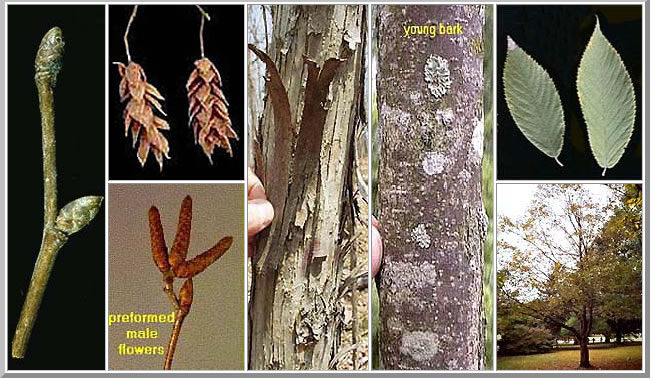
- Leaf: Alternate, simple, pinnately veined, oval to broadly lanceolate, 3 to 5 inches long, with a doubly serrate margin, green above, paler and fuzzy in the axils of veins and on the petiole.
- Flower: Monoecious; males are preformed catkins, 1/2 to 1 inches long, in clusters of 3's (resemble birds toes), present throughout the winter; females appear in spring and are slender, light green catkins, 1/2 inch long, appearing or elongating (males) in spring.
- Fruit: Very distinctive, resembling hops. More specifically, a 1/4 inch nutlet is enclosed in a dried, leafy, inflated sac. Serveral sacs hang from one stem, 1 1/2 to 2 1/2 inches long; maturing in late summer and persisting through winter.
- Twig: Slender, reddish brown, smooth, and may be slightly pubescent. Male catkins present on the end of the branch; buds are small, plump ovate, and covered with green and red-brown, finely grooved (vertically) scales.
- Bark: When young smooth, reddish brown, with horizontal lenticels (cherry like), later turning light brown and developing a shreddy appearance, broken into small plates or loose scales that are easily broken off with a brush of the hand.
- Form: A small tree up to 40 feet tall that develops a round crown of fine branches.
Betula lenta Sweet birch
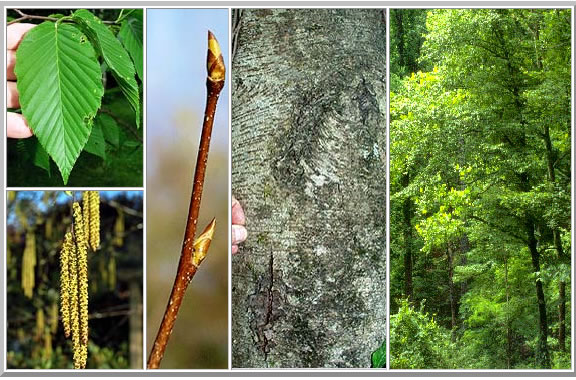
- Leaf: Alternate, simple, pinnately-veined, ovate, with an acute tip and cordate base, singly or irregularly doubly, sharply serrate margins, 2 to 4 inches long, petiole is stout and pubescent, dark shiny green above, paler below.
- Flower: Monoecious; preformed, green male catkins near the end of the twig, 3/4 to 1 inch long; females are upright, 1/2 to 3/4 inch long, green tinged in red, appear or elongate (males) in mid-spring.
- Fruit: Cone-like aggregate, brown, 1 to 1 1/2 inches long, scales hairless or nearly so, containing very small 2-winged nutlets, ripen and break apart in late summer and fall.
- Twig: Twigs are slender, reddish brown and lenticellate with a wintergreen smell when cut. On older trees, spur shoots are apparent. Terminal buds are absent, lateral buds two toned, green and brown.
- Bark: Reddish brown to black on young trees, later gray to nearly black; eventually breaking up into large, thin, irregular, scaly plates.
- Form: A medium sized tree with a single straight trunk reaching up to 60 feet tall.
Betula papyrifera Paper Birch
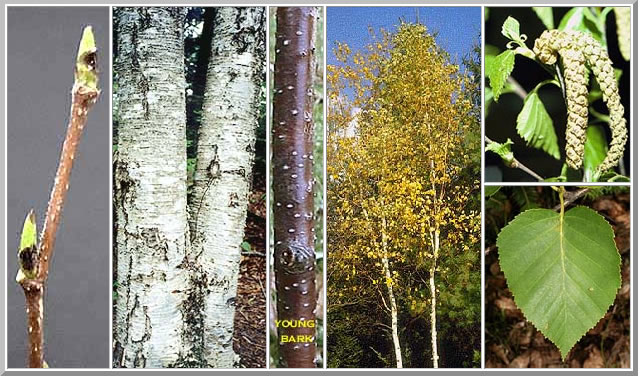
- Leaf: Alternate, simple, pinnately-veined, ovate in shape, 3 to 5 inches long, with irregularly doubly serrate margins, an acute tip and rounded base (occasionally heart-shaped), green above and paler below.
- Flower: Monoecious; preformed male catkins near the end of the twig in groups of 2 to 5, 3/4 to 1 1/4 inches long; female are upright, 1 to 1 1/4 inches long, appear or elongate (males) in mid-spring.
- Fruit: Cone like, cylindrical 1 to 1 1/2 inches long, deciduous at maturity, releasing elliptical 2-winged nutlets, mature in the autumn and disperse over the winter.
- Twig: Slender, dull red-brown, numerous lighter lenticels, lacking wintergreen smell when cut; terminal bud absent, lateral buds are gummy, green and chestnut brown in color, spur shoots present on older growth.
- Bark: Reddish brown with light lenticels on very young stems; later turning chalky to creamy white, peeling in horizontal papery strips; brown to black and may be furrowed at base; orange inner bark.
- Form: A medium sized tree to 70 feet with a pyramidal or irregular crown, often with several trunks.
Bignoniaceae
Habit: woody family, leaves opposite or whorled (rarely alternate), reniform to deltate, margin is smooth, simple or compound, no stipules. False terminal bud. Flowers perfect, fruit is a capsule enclosed in a “bean” like pod that is often present on the tree throughout the winter.
Ecology: Most trees in this family prefer rich well drained soils.
Use: historically used for fence posts, railroad ties, fencepost. Catalpa sphinx larva that feeds on the leaves of the trees used for fish bait. Ornamental.
Catalpa speciosa northern catalpa
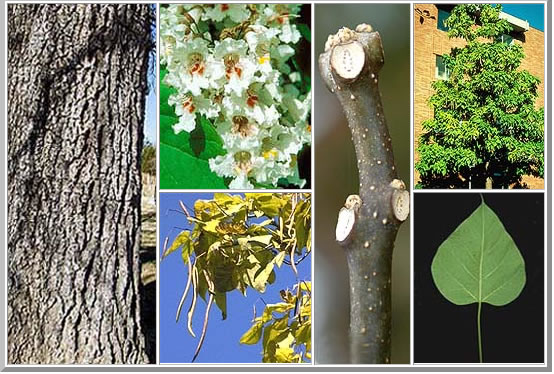
- Leaf: Whorled (or opposite, when whorled one of the three leaves is often smaller), cordate, 5 to 12 inches long, pinnately veined, entire margins, overall soft and flexible feeling, light green to green above and soft pubescence on the underside.
- Flower: Monoecious; very showy, white (yellow and purple spots on insides), 5 fuzzed petals form an overall bell shape, 1 inch long; appear in open, branched, upright terminal cluster (8 to 12 inches long) in late spring.
- Fruit: Long (10 to 18 inches) bean-like, hanging capsules, round in cross section, very stiff; each capsule contains numerous flattened seeds with 2-papery, fringed wings; the seeds mature in autumn, but the capsule may remain attached over winter.
- Twig: Stout, green, and later reddish brown in color, numerous lighter lenticels; terminal bud is absent, lateral buds are small and covered with overlapping, red-brown scales; leaf scars very unique elliptical or round sunken saucers, light in color.
- Bark: Gray to reddish brown, separated into irregular shallow fissures and scaly ridges.
- Form: A medium sized tree to 80 feet with spreading, crooked branches and an irregular crown. The bole may be straight but is generally crooked.
Caprifoliaceae
Habit: mostly woody plants that include vines, shrubs, and small trees. Leaves are simple to pinnately compound, opposite and usually linear. Flowers normally create a flat-topped cyme inflorescence, fruit, usually a fleshy berry.
Ecology: given the adaptive nature of most honeysuckles, members of this family can be found throughout the northern hemisphere.
Use: Elderberry has been clinically shown to contain sambucol which has been successfully used to enhance the immune system. Unfortunately, many of the honeysuckles are used as ornamentals by people unaware of their invasive qualities.
Lonicera japonica Japanese honeysuckle
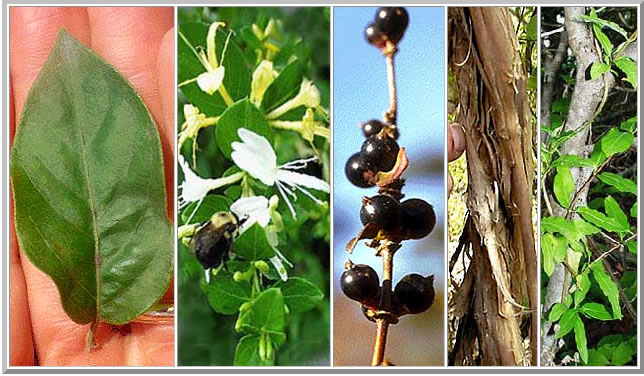
- Leaf: Opposite, simple, ovate to oval, 1 to 2 inches long, entire margin, sometimes lobed, semi-evergreen, light green and somewhat pubescent.
- Flower: Fragrant, 1/2 to 1 inch long, white or yellowish-white long petals, appearing in late spring.
- Fruit: Small (1/4 inch diameter), black berry, often in pairs, ripen in fall and persist into early winter.
- Twig: Slender, initially pubescent, light brown in color developing scaly, thin bark, hollow pith; buds small.
- Bark: Long, shreddy peeling strips, light red-brown to straw-colored.
- Form: A scrambling, twisting vine with no tendrils or aerial roots, forms dense thickets in bushes and trees and sprawls along the ground.
Lonicera xylosteum European Honeysuckle

- Plant: upright, generally deciduous shrubs from 6 to 15 feet in height. Older stems are often hollow.
- Leaves: 1 to 2 1/2 inch, egg-shaped leaves are opposite along the stem and short-stalked.
- Flowers, fruits and seeds: pairs of fragrant, tubular flowers less than 1 inch long are borne along the stem in the leaf axils. Flower color varies from creamy white to pink or crimson in some varieties of Tartarian honeysuckle. Flowering generally occurs from early to late spring, but varies for each species and cultivar. The fruits are red to orange, many-seeded berries that ripen from early summer to fall depending on the species.
- Spreads: prolific fruits are highly attractive to birds. Vegetative sprouting aids in the persistence and spread of these exotic shrubs.
- Look-alikes: native species of shrub honeysuckles; most native bush honeysuckles have solid stems, and exotic species have hollow stems.
Sambucus canadensis Elderberry

- Stems - To +3m tall, woody, glabrous, erect, branching, multiple from base, with large whitish pith. New growth green, glabrous, often glaucous.
- Leaves - Opposite, pinnately compound. Petioles to +6cm long, glabrous, with an adaxial groove. Petiolules to +5mm long. Leaflets typically 5-9 per leaf, glabrous or very sparsely pubescent, oblong to lanceolate, crenate-serrate, to +10cm long, +5cm broad.
- Inflorescence - Terminal compound cymes, typically dome shaped to flattened, to 30cm broad.
- Flowers - Corolla white, 5-lobed, glabrous, 5-6mm broad. Lobes 2.2mm long, 2mm broad, rounded to emarginate at apex. Stamens 5, adnate at base of corolla tube, alternating with corolla lobes, erect to spreading. Filaments white, glabrous, 2.4mm long. Anthers yellow, .5mm long. Style wanting. Stigma 5-lobed, capitate. Ovary inferior, 4-locular. Calyx tube 1mm long, creamy white, glabrous, 5-lobed. Lobes acute, .5mm long. Fruits blackish-purple, globose, glabrous, to 5mm in diameter, 4-seeded.
- Other info. - This species is actually quite aggressive if given the right conditions. It spreads by suckering. The fruits are edible if cooked (boiled) and this plant is the source of the ever popular "Elderberry jelly". The pith of the stems is large, soft, and easily removed and my dad tells childhood stories of making flutes from stems of a similar European species. Don't get too much sap in your mouth though, it's toxic. The plants contain calcium oxalate crystals which do a number on a persons kidneys.
Viburnum dentatum Arrowwood
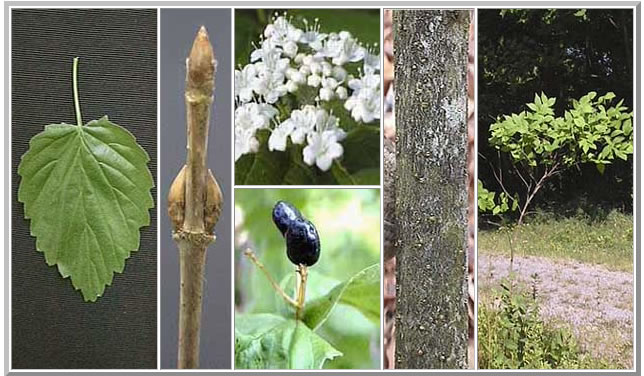
- Leaf: Opposite, simple, oval to elliptical, coarsely serrated margins, 1 1/2 to 3 1/2 inches long, shiny dark green above, paler below.
- Flower: Small, white in flat topped clusters, 2 to 4 inches across, yellow stamens, appearing in late spring.
- Fruit: Bluish black, oval drupes, 1/3 inch long, occurring in clusters, ripening in early fall.
- Twig: Slender, ridged and angled, glabrous or slightly velvety, buds 1/4 inch, green to brown, several scales present.
- Bark: Gray to grayish brown, smooth getting finely scaly with size.
- Form: Many branching shrubs to 10 feet, arching branches forming an overall rounded crown.
Home | Links | Projects | 19th Century Art | Biology | Cartography | Photos | Recipes | Resumè





















